The “AI for Good Global Summit”, being held in Geneva on Thursday and Friday, will bring together around 3,000 experts from companies like Microsoft and Amazon as well as from universities and international organisations to try to sculpt frameworks for handling AI.
UN talks aim to harness AI power and potential
Geneva (AFP) – The United Nations is convening this week a global gathering to try to map out the frontiers of artificial intelligence and to harness its potential for empowering humanity.
Issued on: 04/07/2023 – 05:50Modified: 04/07/2023 – 05:46
“This technology is moving fast,” said Doreen Bogdan-Martin, head of the International Telecommunication Union, the UN’s information and communications technology agency that convened the summit.
“It’s a real opportunity for the world’s leading voices on AI to come together on the global stage and to address governance issues,” she told reporters.
The “AI for Good Global Summit”, being held in Geneva on Thursday and Friday, will bring together around 3,000 experts from companies like Microsoft and Amazon as well as from universities and international organisations to try to sculpt frameworks for handling AI.
“This technology is moving fast,” said Doreen Bogdan-Martin, head of the International Telecommunication Union, the UN’s information and communications technology agency that convened the summit.
“It’s a real opportunity for the world’s leading voices on AI to come together on the global stage and to address governance issues,” she told reporters.
Benefiting humanity?
The Geneva-based ITU feels it can bring its experience to bear on AI governance.
Founded in 1865, the ITU is the oldest agency in the UN fold. It established “SOS” as the Morse code international maritime distress call in 1906, and coordinates everything from radio frequencies to satellites and 5G.
The summit wants to identify ways of using AI to advance the UN’s lagging sustainable development goals on issues such as health, the climate, poverty, hunger and clean water.
Bogdan-Martin said AI must not exacerbate social inequalities or introduce biases on race, gender, politics, culture, religion or wealth.
“This summit can help ensure that AI charts the course that benefits humanity,” UN chief Antonio Guterres said.
However, while AI proponents hail the technology for how it can transform society, including work, healthcare and creative pursuits, others are worried by its potential to undermine democracy.
‘Perfect storm’
“We’re kind of in a perfect storm of suddenly having this powerful new technology — I don’t think it’s super-intelligent — being spread very widely and empowered in our lives, and we’re really not prepared,” said serial AI entrepreneur Gary Marcus.
“We’re at a critical moment in history when we can either get this right and build the global governance we need, or get it wrong and not succeed and wind up in a bad place where a few companies control the fates of many, many people without sufficient forethought,” he said.
Last month, EU lawmakers pushed the bloc closer to passing one of the world’s first laws regulating systems like OpenAI’s ChatGPT chatbot. There is also growing clamour to regulate AI in the United States.
ChatGPT has become a global sensation since it was launched late last year for its ability to produce human-like content, including essays, poems and conversations from simple prompts.
It has sparked a mushrooming of generative AI content, leaving lawmakers scrambling to try to figure out how to regulate such bots.
Juan Lavista Ferres, chief data scientist of the Microsoft AI For Good Lab, gave an example of how AI could be used “to make our world a better place”.
He compared the more than 400 million people diagnosed with diabetes, a major cause of blindness, with the small number of ophthalmologists.
“It’s physically impossible to diagnose every patient. Yet we and others have built AI models that today can take this condition with an accuracy that matches a very good ophthalmologist. This is something can even be done from a smartphone.
“Here AI is not just a solution, but it’s the only solution.”
6 July 2023 Economic Development
The development of artificial intelligence, or AI, “for the good of all” requires guardrails grounded in human rights, transparency, and accountability, UN Secretary-General António Guterres said on Thursday.
He stressed that AI must benefit everyone, including the third of humanity who are still offline, and insisted on the need to urgently find consensus on what the guiding norms for AI deployment should be.
The UN chief was speaking at the “AI for Good” Global Summit organized in Geneva by the International Telecommunication Union (ITU), bringing together governments, civil society, UN agencies, AI innovators, and investors.
The event is exploring ways in which AI can be used to help the world achieve the Sustainable Development Goals (SDGs).
https://www.france24.com/en/live-news/20230704-un-talks-aim-to-harness-ai-power-and-potential
Get the SDGs back on track
At the summit, ITU Secretary-General Doreen Bogdan-Martin called for global cooperation to “ensure AI reaches its full potential, while preventing and mitigating harms”. At the mid-point towards the deadline that humanity has given itself to achieve the SDGs, the world was off-track, the ITU chief said, and using AI to accelerate progress was now “our responsibility”.
In an ideal scenario, Ms. Bogdan-Martin said that we would be able to successfully harness AI to find cures for diseases like cancer and Alzheimer’s, step up clean energy production, and support farmers in boosting crop yields.
AI risks on the rise
But, a dystopian future was also possible, in which AI destroyed jobs and enabled an uncontrollable spread of disinformation, or in which only wealthy countries reaped the benefits of the technology, the ITU Secretary-General said.
Earlier this year, UN human rights chief Volker Türk had warned about the rapid and unchecked advances in generative AI. He said that “human agency, human dignity, and all human rights are at serious risk”, calling for governments and businesses to anchor the technology’s development in rights considerations.
A ‘historic’ moment
The ITU chief stressed that the AI Summit was taking place at a “historic” moment when it was crucial to push for AI governance and ensure its inclusive, safe, and responsible deployment.
“The future of AI has yet to be written,” she said.
Innovative robots
More than 50 robots will be present at the Summit as part of a “Robotics for Good” exhibition. Their inventors will demonstrate how the robots can support people’s health, provide educational services, help persons with disabilities, reduce waste, and assist emergency response in disasters.
A number of humanoid robots were billed as “speakers” at the event, and their capabilities as caregivers and companions for elderly people were on display.
A press conference is due to take place on Friday where some of the humanoid robots will be taking questions.
Exploring the potential of humanoid robots for social good
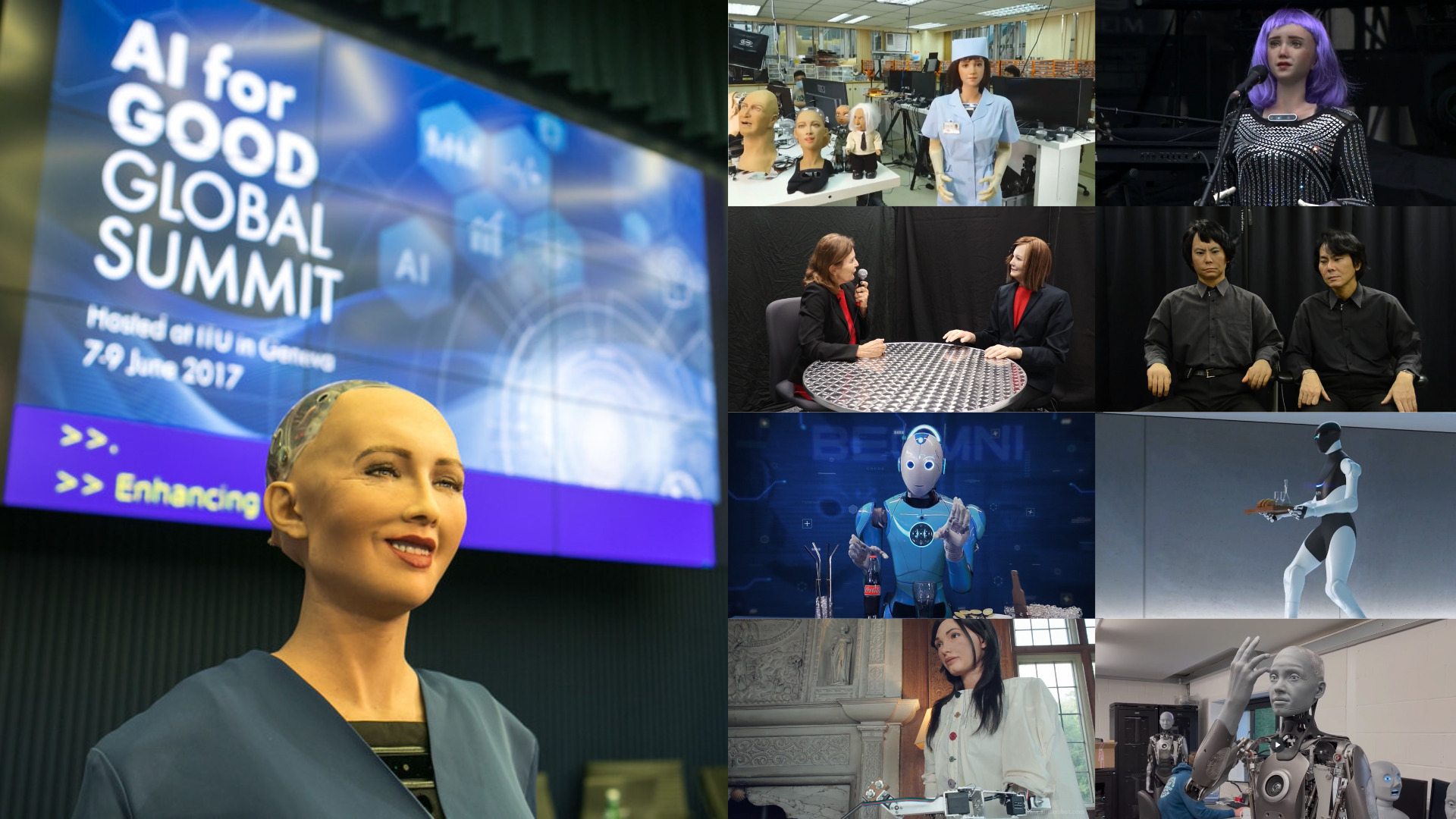
Global Summit | Robotics for Good
By Irina Timoshenko
The 2023 edition of the AI for Good Global Summit will take place in Geneva, 6-7 July. Over 30 cutting-edge robots are gearing up to take part in the Robotics for Good exhibition, which will show the potential of autonomous robots to drive progress towards the United Nations’ Sustainable Development Goals (SDGs).
In this series of blog posts, we will be introducing some of the robots attending the Summit and explain how they are contributing to the SDGs.
Episode 1: Humanoid robots
Today we would like to introduce humanoid robots – machines designed to emulate both the appearance and actions of humans through the use of sensors, actuators, and software that enable interaction with the environment and execution of tasks comparable to those done by humans. Humanoid robots have various applications, including healthcare, education, entertainment, and research, which have the potential to improve lives and open up opportunities for innovation.
READ MORE: Discussing the future of Robotics for Good at the AI for Good Global Summit 2023
Presenting cutting-edge humanoid robots
The upcoming AI for Good Global Summit in 2023 is set to make history by bringing together nine humanoid robots under the same roof. Each of them has its unique set of features and capabilities, making them a fascinating subject of study. Here’s a closer look at each of them:
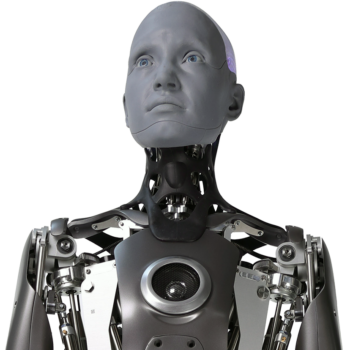
Ameca, designed by Engineered Arts, is one of the world’s most advanced human-shaped robot, with a realistic appearance and lifelike movements. The robot has a range of sensors and cameras that allow it to detect and respond to people in its environment, as well as to recognize and track individual users. It will be presented during the Summit by Will Jackson, CEO at Engineered Arts.
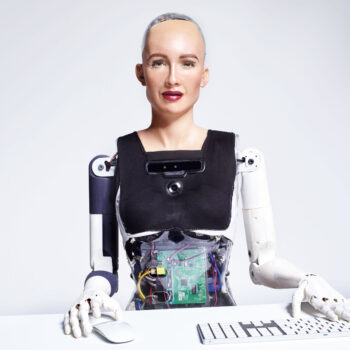
Sophia, created by Hanson Robotics, is a humanoid robot that has gained international fame for its striking appearance and advanced capabilities. Sophia’s design is intended to resemble a human, and is capable of expressing a range of facial expressions and gestures. Sophia’s most impressive feature is her sophisticated neural network that enables her to process speech and facial recognition, making her capable of engaging in conversations and recognizing individuals. Sophia will be presented by David Hanson, CEO and Founder at Hanson Robotics.
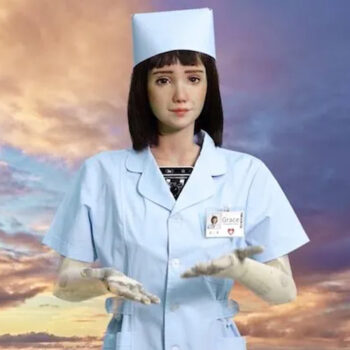
Sophia also has two sisters, both developed in partnership with Hanson Robotics and SingularityNET. The first one is Grace, specifically designed to provide assistance and companionship to elderly individuals and people with disabilities. Grace can carry out a range of tasks, including meal preparation, cleaning, and medication reminders, with the aim of enhancing the quality of life for those in need.

The second is Desdemona, the rock star robot of the Jam Galaxy Band that runs on music and electricity and is on a mission to share her belief that the world can be changed for the better through the power of AI in the creative arts. Desdemona and Grace will be presented by Ben Goertzel, CEO and Founder of SingularityNET.
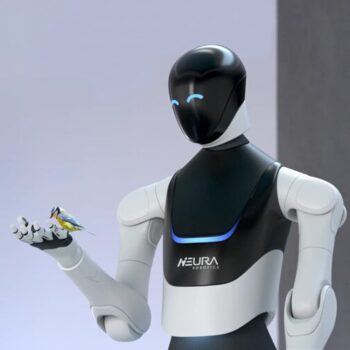
4NE-1 is a robust robot based on verified, cognitive technology developed by Neura Robotics. Thanks to its integrated AI, 4NE-1 can recognize different human voices, languages, and even voice tones and emotions, allowing the robot to interact with humans through voice and gesture control. With unique and patent-pending Touchless Safe Human Detection technology, a sensor that can detect humans and other moving objects even when the sensor’s view is obstructed by clothing, 4NE-1 can interact with humans naturally and safely.

Geminoid HI-2 is a tele-operated android developed by Hiroshi Ishiguro Laboratories in Japan. The Geminoid HI-2 robot is designed to look and act like a human being as closely as possible. It has a realistic silicone skin, eyes with built-in cameras, and a range of facial expressions and movements that are controlled by motors and servos located beneath the skin. It is designed to resemble and behave like its creator, Professor Hiroshi Ishiguro, who is going to present Geminoid at the AI for Good Summit 2023.
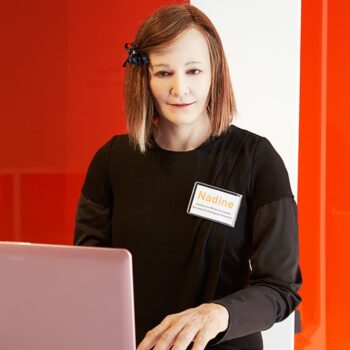
Nadine is another humanoid social robot that is modelled on her creator, Professor Nadia Magnenat Thalmann from the University of Geneva – MIRALab. One of the key features of Nadine is its ability to learn and remember individual users over time. This means that the robot can tailor its interactions to each user’s preferences and needs, and develop a more personalized relationship with them. She has worked in banks and elderly homes.
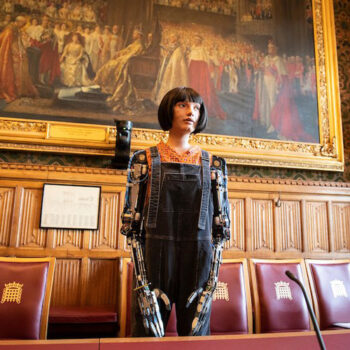
Ai-Da is the world’s first ultra-realistic humanoid robot artist created by Aidan Meller. Ai-Da is designed to be the world’s first AI artist capable of creating original artwork using a combination of machine learning algorithms and human guidance. The robot has been featured in a range of exhibitions and galleries around the world, showcasing its unique blend of technology and art. It has been praised for its ability to challenge traditional notions of what constitutes art, as well as for its potential to democratize the art world by making it more accessible to people who may not have had the opportunity to create or experience art otherwise.
Beomni is the world’s first fully functional general-purpose humanoid developed by Beyond Imagination. This AI-powered robot is designed to interact with humans and assist them in various tasks. It can perform a range of movements and actions, enabling remote work at a high level of fidelity to be done from around the globe. It will be introduced by Harry Kloor, CEO at Beyond Imagination.
Humanoid robots supporting sustainable development
Humanoid robots can be a significant contributor to achieving SDG 3: Good Health and Well-Being. They have the capacity to provide companionship and support for elderly people and those with chronic conditions, and can assist healthcare workers with tasks such as monitoring vital signs and providing medication reminders. For instance, Grace and Beonmi can improve access to healthcare services, particularly for elderly people and individuals with disabilities by providing personalized care and support. Nadine, on the other hand, can contribute to improving health and well-being by assisting healthcare providers in delivering care to patients through telepresence and virtual assistants.
In addition to healthcare, humanoid robots can be used in educational settings to help children with special needs to learn and develop social skills, promoting SDG 4: Quality Education. For example, Geminoid can be used as a tool for improving the quality of education, providing remote lectures and presentations. Ai-Da can teach students about the intersection of art and technology, promoting innovation and creativity.
Robots such as Ameca and Grace can contribute to SDG 10: Reduced Inequalities by helping and supporting people with disabilities, reducing inequalities in access to healthcare, education, and other services. Furthermore, humanoid robots such as Sophia can promote gender equality by challenging gender stereotypes and providing positive role models for women and girls.
When it comes to SDG 12: Responsible Consumption and Production, humanoid robots such as 4NE-1 and Ai-Da are leading the way. 4NE-1 is improving the efficiency and productivity of manufacturing processes, leading to more sustainable production practices, while Ai-Da’s use of various mediums to create art could potentially reduce waste by utilizing materials in innovative ways and promoting more responsible consumption and production.
Finally, humanoid robots can also contribute to SDG 9: Industry, Innovation and Infrastructure. They have the potential to play a significant role in building resilient infrastructure and promoting sustainable industrialization. By enhancing productivity, driving innovation, and promoting sustainability, humanoid robots are accelerating progress towards a better future.
Register for the AI for Good Global Summit to meet and interact with the humanoid robots and its creators.
